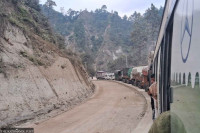Opinion
Class in the past
Venerable Durbar High School is a window into the early days of education in Nepal
Niranjan Mani Dixit
Established during Rana rule, Durbar High School is Nepal’s first school. The school building features British architecture and lies next to Rani Pokhari built by king Pratap Malla in 1670. The school was originally an elementary English school. Feeling humiliated by not being able to communicate in English during his visit to Europe, Jung Bahadur Rana set up a school at his residence in 1853 with two teachers imported from England to teach children of the ruling families. The school was later shifted to Thapathali Durbar with an Englishman called Kenning as its first teacher. Named Durbar School (palace school), it marked the beginning of modern education in Nepal, but only the ruling Ranas and their sons could attend it. In 1876, the school began admitting children of high class government officers too.
The school had to shift constantly from Thapathali Durbar to Charburja Durbar, Seto Durbar and Narayanhiti Durbar before being located in a small shed in Jamal. Finally in 1891, the then prime minister Bir Shumsher Rana had the present long building built on the west side of Rani Pokhari. In 1900, Durbar School was turned into a public school. In 1967, its name was changed to Bhanu Madhyamik Vidyalaya.
Initially, the school as a feeder institution was affiliated with Calcutta University, and students had to travel to Kolkata for their high school entrance examination until an examination centre affiliated with Patna University was opened in Kathmandu in 1929. In 1933, the government established the School Leaving Certificate Examination Board and students did not have to travel to India for their exams. The historical school building also possesses archaeological importance and is loved by millions of people, but it has not been reconstructed after being destroyed by the earthquake of April 2015. Classes are being held under tents which is shameful indeed.
The unsung hero
A group of legendary teachers like Basudev Bhattarai, Partha Mani AD, Bodh Bikram Adhikari, Rudra Raj Pandey, Tirtha Prasad Pradhan, Devi Prasad Rimal, Tulsi Prasad Dhungel and Bhairab Bahadur taught at Durbar High School during its early days. Partha Mani, respectfully called ‘Madsab’, stands out among them for imparting education to thousands of children in Nepal during the despotic Rana regime when Nepalis were deprived of educational opportunities. He was committed to his teaching profession and was highly revered by his students, departmental colleagues, high ranking bureaucrats and intellectuals.
Partha Mani was of dark complexion and of rather short stature. He taught at Durbar High School continuously for over 30 years. He was appointed by the then prime minister Chandra Shumsher Rana who ruled Nepal for 29 years. Partha Mani received a monthly salary of Rs125 in silver coins. For additional income to support his extended family of 16 members, he gave private tuition in the mornings until he retired. After the downfall of the Rana regime in 1951, he was appointed as a private teacher by Narayanhiti Royal Palace. Since he was no longer able to ride his Raleigh bicycle, he was provided a deluxe transportation facility. Partha Mani also wrote many course books allowing the school to replace books borrowed from the British-Indian education system. He wrote Sanskrit and English grammar books for different grades, besides translating selected plays by William Shakespeare into Nepali.
Partha Mani’s student life was miserable as he was underprovided even though he had received a full scholarship due to lapses on the part of the head of the Buying Agency in Kolkata. However, he wholeheartedly dedicated himself to acquiring an education. As a dutiful son, he regularly visited his aged father Ramchandra who was living a spiritual life in a narrow alley in the Hindu holy city of Varanasi in India. Imagine Partha Mani, an orthodox Brahmin from the hills clad in ‘daura suruwal’ and ‘dhaka topi’, travelling on foot and by lorry and train to reach Varanasi. It was an adventurous journey which lasted several days.
Partha Mani led a minimalist lifestyle. He was humble and performed dutiful actions, socially and professionally, in the service of his motherland Nepal until he breathed his last in 1976 at the age of 76 due to cancer. Ironically, the departed souls of commendable teachers who nurtured and contributed their utmost, and the souls of students such as martyrs Ganga Lal Shrestha and Shukra Raj Shastri who graduated from this iconic school at Rani Pokhari, seem to have been grossly abandoned due to government negligence.
Dixit is an expert in integrated development issues




 6.94°C Kathmandu
6.94°C Kathmandu












